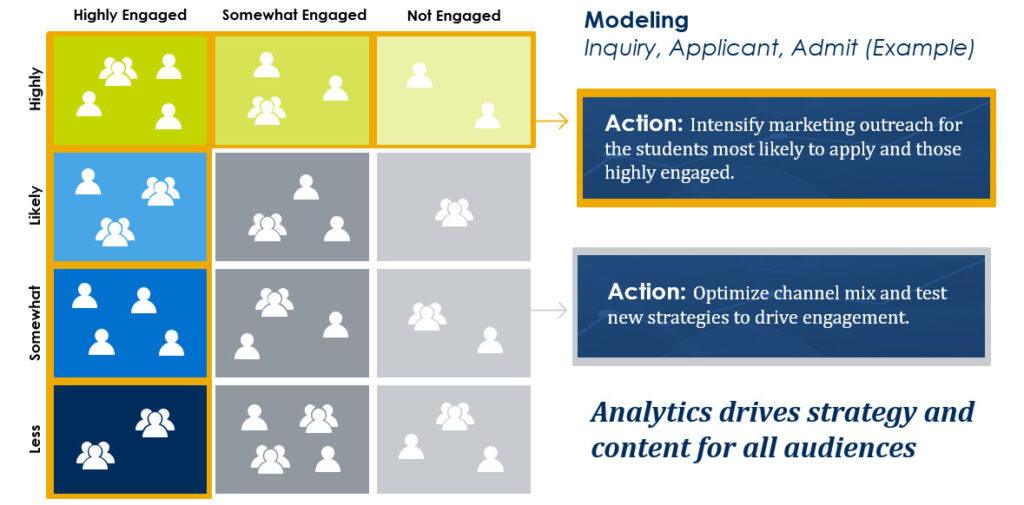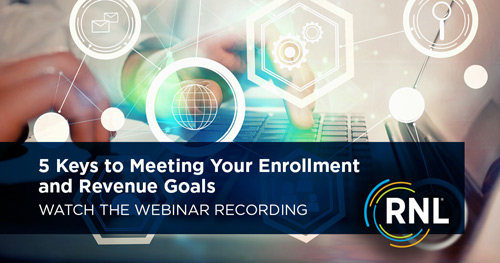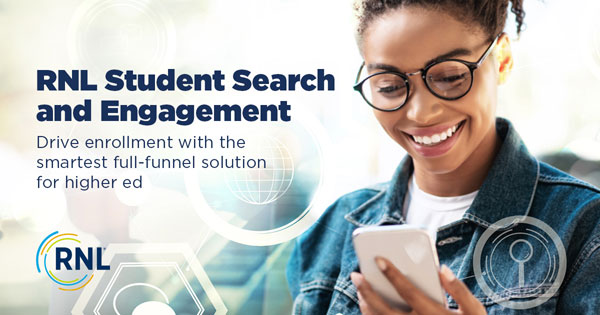enrollment
3 Keys to Taking a Full-Funnel Approach to Student Search and Reaching Your Enrollment Goals

I have been an enrollment management professional for more than 20 years, both as an on-campus enrollment manager and as an RNL partner to 125 colleges and universities during my tenure. I have seen every challenge related to college student search and enrollment over those years, but I don’t think any of us were prepared for the once-in-a-lifetime disruption of the pandemic—to the students, to their parents, and to your campuses.
What’s more, the pandemic exacerbated another existential crisis for higher education: the enrollment cliff. I remember when we started talking about the enrollment cliff 10 years ago, and now it is here at our doorstep. (My colleague Scott Jeffe also discussed how this has implications for every student population.)
As if that is not enough, the ability to engage and attract students is undergoing a fundamental shift. Three out of four institutions have gone test optional. That has had a dramatic impact your ability to purchase names and fill your funnel with the students you need to meet your enrollment goals. The way students search for college has also changed dramatically, using texting, social, video, and chat in addition to traditional channels such as email, phone, and print. They expect more personalization and curation of content tailored to their needs, the kind of experience they have with companies such as Amazon and Netflix.
What is the solution?
A full-funnel approach to college student search

We can no longer think of “student search” as a top-of-the funnel event. Instead, we have to be intentional and specific on engaging students and families throughout the funnel. Rather than the typical approach of focusing on prospect-level search and bringing the institution to the student, we now need to figure out and focus on the ways we continue that engagement—not only to improve volume at the top to keep those students engaged and progressing toward inquiring, applying, and depositing.
How do we accomplish these goals? My colleagues Josh Robertson and Jason Langdon recently joined me to discuss this topic in a webinar, and here are the three of the keys we discussed for taking a full-funnel approach to college student search.
1. Increasing volume through alternative sources and approaches to student names
Increasing volume is a little intimidating, because we’ve seen the shift in the number of test takers from the traditional sources of student names. Some of the volume is still there, but we’ve lost a piece of that quantifiable information and quality data that we’re used to with test taker information.
Today, increasing volume is really about diversification—not only in sources, but also in student populations, geographic distribution, and influencers. And there are two major ways RNL helps you diversify how you build volume and find the names you need:
- Alternative name purchases from vendors. RNL has developed a proprietary network of partners to provide the volume and quality institutions need in light of the test-optional environment.
- Digital outreach in relevant channels. Reaching students in the platforms they use every day is critical. We help bring students to our campus partners through digital advertising and social media channels to attract prospective students and build a pool of prospects who will become inquiries.
This key to remember is that quality of names is even more important than quantity. Having a large number of names that don’t convert wastes your limited dollars and reduces your ROI. That comes down to having sources of names you can trust and digital outreach that will attract students who align with your enrollment goals and are from markets where you have the best chances to succeed.
2. Enhancing your analytics to combine historical and engagement data
Analytics is a critical piece of modern enrollment management. Having the right analytics:
- Increases visibility into student behavior.
- Assesses the effectiveness of your recruitment strategies.
- Informs your decision making, both for planning campaigns and making those critical adjustments during campaigns.
- Focuses your time on the students and strategies that will have the greatest impact on your enrollment goals.
Many institutions use analytics, but most are not getting a prescriptive picture from their analytics. By that I mean that they may be looking at historical modeling that uses past student behavior to predict enrollment, but they are missing engagement metrics that tell them how students are engaging right now. The key is combining historical and engagement data to provide that clearer picture of what is happening in the funnel.
Take your inquiry pool. Historical predictive modeling is very helpful, but when you add behavioral engagement modeling, it is a game-changer for how you can model behavior, focus your efforts, and help you reach the students who are engaged.
Here’s an example of how this combines together. The left vertical side of this chart shows the likelihood to enroll based on historical data (from less likely to highly likely to enroll). The top shows the engagement from highly engaged to not engaged.
Driving action by using historical modeling with engagement scoring

When you are able to do this enhanced modeling, you can really pinpoint where to spend your time. All your students who are highly engaged will likely be worth your attention, including those who might be rated lower with historical modeling. In a similar fashion, you will uncover students who have high likelihood of enrolling but are not engaged, allowing you to intensify your outreach to those students. For those in the middle to bottom right, you can optimize your channel mix and test strategies to drive engagement, giving you a greater opportunity to move some of those students toward enrollment.
3. Increase conversion and velocity throughout the funnel with students and parents
“Speed to lead” is a big component of the graduate and online enrollment space, where the search process for prospective students is compressed and they expect much more rapid responses from institutions. But this has also become more critical for undergraduate enrollment, both with students and parents. Think about their daily experiences: they don’t wait weeks or even days to hear back from the companies and organizations they interact with. They receive responses very quickly, often instantly. That is now a key part of the student search experience as well.
Going hand-in-hand with that is providing the information and engagement students and parents want at the moment they need it. At any given time in your funnel, you have an audience that is researching and engaging with your campus in a variety of ways. They all have different information needs that will drive a decision—to inquire, to apply, and to accept admission and move toward enrollment. In a similar fashion to the way our analytics are multilayered, so are communications today. There is no linear comm flow that’s all about you. Today you must have personalized engagement with relevant information at key decision points throughout the funnel.
You also have to use all relevant channels in your outreach. Students use everything today. In our E-Expectations research, we see that search is increasingly digital and online, with institutions using everything from Google and your website to TikTok and AI chatbots to get the information they need. But they also still use email and ask for print materials. This goes for parents as well, who need their own tailored engagement experiences. There are no greater enrollment influencers than parents, and when they are engaged, they can help push students more quickly through those key decision points. With both audiences, you have to be sure you are providing relevant information in the channels they use if you want to increase conversion.
How you can engage more students and parents during the entire college student search process? Let’s talk.
We have added these capabilities and much more to RNL Student Search and Engagement this year, giving you the full-funnel college student search solution that lines up with how students engage, apply, and enroll. From analytics and increasing name volume to increasing conversion and uncovering insights through analytics, this is a truly holistic approach to student search. Ask for a complimentary consultation with our enrollment experts and we’ll discuss how you can consistently reach your enrollment goals, even in an uncertain market.
Maximize the impact of your student search campaigns on enrollment
Ask for a free walkthrough of RNL Student Search and Engagement and see how you can increase volume at the top of the funnel, increase conversion and velocity through the funnel, and achieve your enrollment goals.


